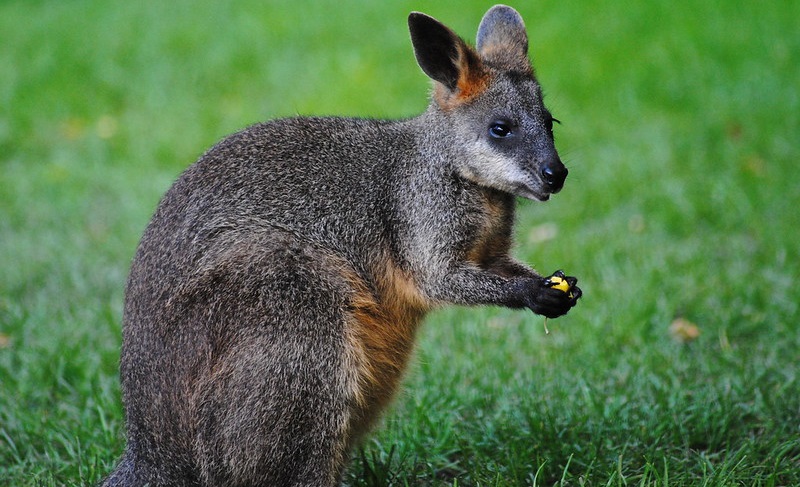Wallabies look like small kangaroos, so it is tough to think they are not the same animal. Although they belong to the same family, the wallaby refers to a group of marsupials that are smaller than roos.
We will take you through a lot of information about this cute, fascinating collection of animals for clarity. Although each deserves its own article, we can provide only an overview here. But once you’re done reading, you should have an excellent understanding of these animals.
Wallaby Marsupials or Brush Kangaroos
You may hear different names for wallabies, but that’s because these cute mini roos or roos are distinct. We will clarify the terms here, starting with the proper scientific name. Then, we will discuss the joeys.
The Complicated Scientific Name
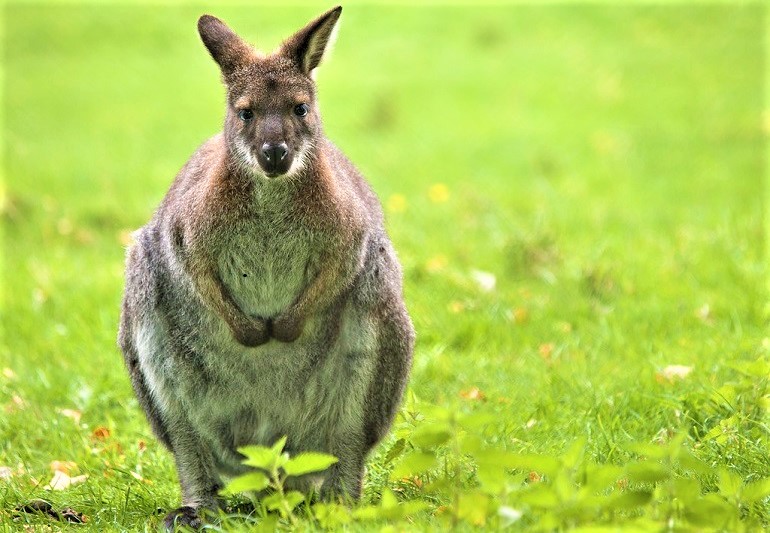
The actual scientific name of this family is Macropodidae or macropods. Macropods refer to the roo family, but the kangaroo is much larger than the wallaby, which is the Macropus eugenii species.
Both are marsupials, meaning they have pouches. Others are the koala, the Tasmanian devil, wombats, and opossums. All of these macropods have a pouch.
A Small Wallaby is Called a Joey
No one seems to know where the word “joey” comes from, but it was first recorded in about 1839. It’s probably safe to say that this name is some derivative of the Australian Aboriginal people who named the wallaby. All young wallabies are called joeys.
Just as fascinating is that the males are known as jacks, bucks, or boomers. Likewise, females are does, jills, or flyers. The connection between jacks and jills is at least straightforward, as these are the characters in a famous nursery rhyme.
Similarly, you can use your imagination regarding the term “flyer,” These small kangaroo-type creatures tend to fly through the air when making their massive leaps.
When bunched together during grazing, these animals look like a mob. Other collective terms are court, troop, or troupe. You gotta love the Aussies for their fascinating etymology either way.
The Dharug Eora Walabi Etymology
Etymology is the evolution and use of words with roots and modern interpretations. So, the name of this animal comes from somewhere. Some say that origin is the Yuin-Kuric people who lived in the Sydney area of Australia at least two centuries ago.
This group of people used a language known as Dharug, Dharuk, and Gadigal, spoken by a group of Australian Aboriginal people. These people originally named the wallaby the Dharug waliba or walabi.
On the other side of the coin, historians say that the Eora or Yuri people of New South Wales’s coastal regions are the originators of the name. This indigenous tribe also lived near Sydney on the eastern coast of Australia, so it is conceivable they shared close ties with the Yuin-Kuric people.
What Does a Wallaby Look Like?
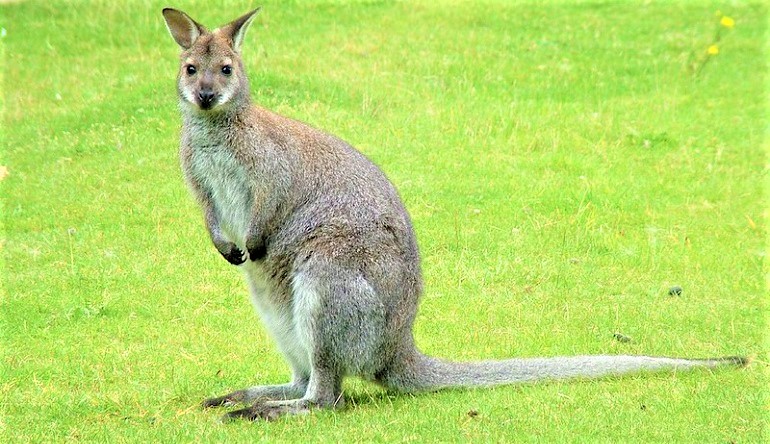
Focusing on the size and appearance of the wallaby, you can expect it to look a lot like the kangaroo. But as much as the wallaby resembles its larger family member, they are a separate but not distinct species.
Size and Appearance
Now is an excellent time to give several audience insights into their physical characteristics. There are over 30 species of wallabies. Wallaroos are something else that are sized between these two macropods.
Wallabies have pointy faces, large ears, and eyes. They also have flat teeth for grinding their food. Their bodies are well-rounded, and they have powerful hind legs. Their forearms are short and thin and less powerful than their back legs. It also has short hind limbs in relation to members of the kangaroo family.
Wallabies can go hopping off at high speeds of 18 to 29 miles per hour and jump up to ten feet into the air using their powerful hind legs. These figures depend on the type of wallaby.
The Tammar wallaby also has tendons that act like a spring in its back legs. This feature helps it to save energy and increase its muscle power. Other supportive features are their powerful tails.
Wallabies range from 13 to 41 inches (body length). The tail can grow to between 20 and 28 inches. Add the body length and tail; they can be quite long mammals.
The smallest (dwarf wally) weighs about 3.5 pounds. The largest species (black-striped wallabies, scrub wallabies, eastern brush wallabies) reach weights of 24.3 pounds, depending on their genus. The bucks’ weight typically exceeds the females’.
Their fur colors range from red or rufous to brown or tan, white, grey, and black. Their coats have longer, more luxurious fur than roos and can contain multiple colors rather than a single shade. Typically, they have darker forelimbs, snouts, and ear tips, whereas these areas are uniform in their larger relatives.
Is a Wallaby a Kangaroo?
The wallaby is classified as the Notamacropus genus, and the kangaroo, the genus Macropus Osphranter, includes wallaroos. The species include small animals like:
- Rock
- Hare wallabies
- Nail-tailed
- Brush
- Quokkas, and Tasmanian devils, among others.
Wallaby Classification
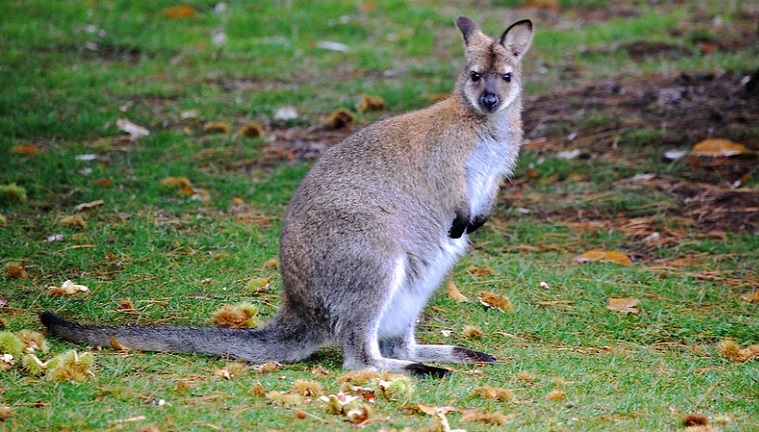
While these cute little mammals may not be genetically original, biologists have sorted them into various groups. These groupings make it much easier to understand their differences and to recognize these small animals.
The Notamacropus genus group or brush wallabies are the closest relatives of the larger roos. Nine species of brush wallaby category populate the rural areas of southern Australia.
Biologists are trying to increase the numbers of rock wallabies, some of which are endangered. This animal is part of the Petrogale category and thrives in rocky terrain because of its modified feet.
Their feet have evolved well to cope in this rugged terrain as they can grip and dig easily with their huge claws. A breeding program ensures that this mammal can soon move from the safety of captivity to living in the wild once again.
Due to predation, the Lagostrophus fasciatus, or banded hare, is the last subspecies of the Sthenurinae family, which once had many species.
Close to becoming extinct, this banded hare marsupial now occupies small tracts of land on two islands off the coast of Western Australia. However, this species is more closely related to others than to the Lagorchestes genus of hare wallabies.
At least five species inhabit the island of New Guinea.
Wallaby Species
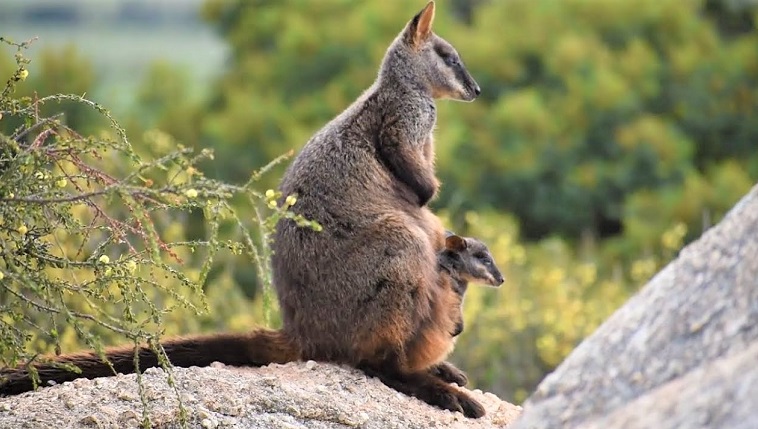
There are over 100 species. Some of these are extinct, others are endangered, and some are thriving. These include 10 rock wallabies species, 2 hare wallabies species, 3 nail-tailed wallabies species, 7 forest wallaby species, and one swamp wallaby species.
Here is a list of some of the more familiar ones that you may have seen on T.V. or in magazines and books.
Forest Wallabies
The Genus Dorcopsis of forest wallabies consists of seven species:
- The black forest
- Gray forest
- Brown forest
- White-striped forest
- Macleay’s forest
- Small Papuan forest
- Greater forest
Genus Notamacropus
The Genus Notamacropus has seven species as one has become extinct, including:
- Notamacropus Agilis or agile
- Notamacropus Dorsalis or black-striped
- Notamacropus Rufogriseus or red-necked wallabies
- Notamacropus Eugenii or Tammar
- Notamacropus Parma or Parma
- Notamacropus Irma or Western brush
- Notamacropus Parryi or Whiptail
Genus Lagorchestes – Hare Wallaby
The Genus Lagorchestes has four species, including:
- Eastern hare
- Lake Mackay hare
- Rufous hare
- Spectacled hare
The first two species from this group of four are extinct due to being hunted by humans.
The Pademelon or Scrub Wallaby
Another name for scrub wallabies is the pademelon. These pademelons include seven species from the Genus Thylogale. Three species from this genus are the Tasmanian pademelon, the red-neck pademelon, and the red-legged pademelon.
Other Wallaby Genii
The swamp or black wallaby is still alive and is part of the genus Wallabia bicolor.
The quokka is also known as the short-tailed scrub wallaby and belongs to the Genus Setonix.
Population Range of Wallabies

Wallabies are native to Australia and inhabit southern, western, eastern, and Northern territories, central Australia, and other regions. These diverse creatures live in Tasmania, New Guinea, and southeast Indonesia.
Their population range extends to the Bismarck Archipelago and Recherche Archipelago, also known as the Bay of Isles. This archipelago consists of over 100 islands. Of these, two offshore islands are the habitat for some of these macropods.
Where Do Wallabies Live?
As cute as they are, don’t make the mistake of thinking that these creatures are delicate. They’re not. Several species are robust and can live in the harshest terrains. We are talking about Australia, after all.
You can find them inhabiting marshlands or swampy regions, or wooded areas. They also live in open plains but prefer the security of brushland, forests, or rocks around them.
Wallaby Diet
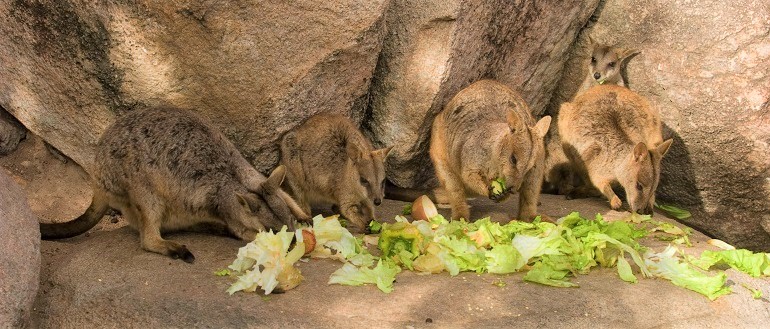
Since they are herbivores, they prefer a diet of various types of grass. They also chew on other plants in the wild, like seeds, herbs, leaves, and other vegetation.
They eat fruits if available and even survive drinking salt water, like the Tammar wallaby. In arid regions, they will add roots to their diet as a source of food and moisture.
Facts About Wallabies
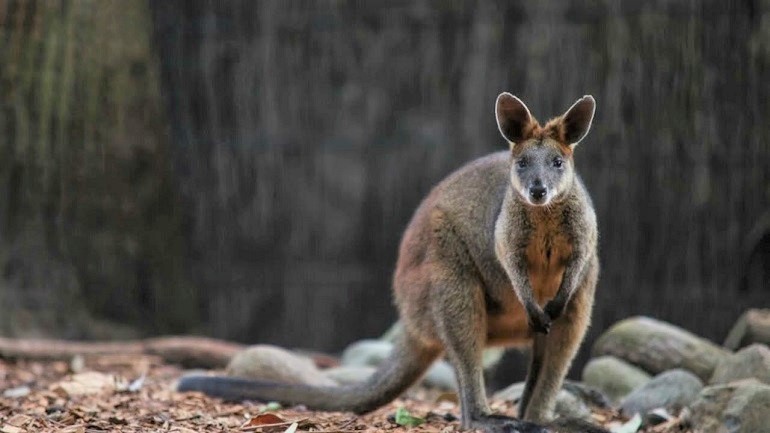
Strength
Many of the larger ones that look like roos are strong. The fact that they can jump up to six feet high and run at speeds of close to 30 miles per hour gives you an idea of their abilities.
Social Structure and Behavior of Wallabies
Over half are solitary, although they can sometimes be sociable. For instance, the females with babies in the pouch and no young ones on foot will mingle with each other. But if the females have babies on foot and small young in the pouch, they become more solitary.
Bucks of similar sizes will socialize, but those like the red-necked wallaby are solitary creatures. However, large mobs of up to 40 or more can be seen feeding together. The bucks will fight each other to establish dominance and hierarchies to win over females for reproduction purposes.
Reproduction and Development
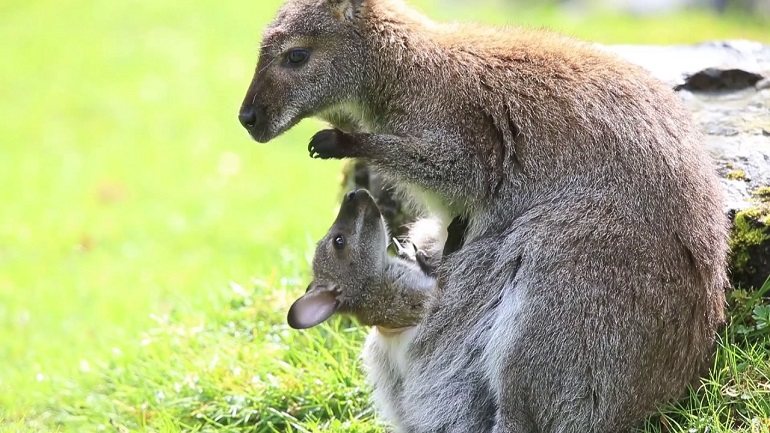
Macropods mate like other mammals and females become pregnant like other mammals. The female kangaroo releases an egg from her ovary, which moves down the fallopian tube where the sperm can reach and fertilize it. After fertilization, it attaches itself to the wall of the uterus.
Instead of a placenta forming like with other mammals, the egg consumes its yolk and must birth after a short 28 days. When ready, the female grooms her pouch and births the tiny joey through her cloaca under her tail. The joey then climbs into her pouch using its arms, the only part that is strong enough at this stage.
It instinctively finds a nipple and attaches itself to feed automatically as the nipple swells inside its mouth. Only once the joey’s jaws are developed can it feed when it wants.
A really fascinating part of their reproduction is that the female mates again after giving birth. The second baby lies in wait, undeveloped until the first baby leaves the pouch. This process is known as embryonic diapause. Many wallabies have this ability, which is handy for replacing a baby if it dies early.
How Long Do Wallabies Live?
If they live in a zoo, they can live as long as 15 years but tend to have a shorter lifespan of about 12 years in their natural environment.
Sleeping Habits
Many of the smaller species are nocturnal or crepuscular. Larger species tend to be diurnal. They use their forelimbs to support their heads and rest like people on their sides or backs. Tree wallabies sleep in trees.
Potential Predators:
These include people, foxes, cats, eagles, pythons, and dingo’s.
Conservation and Threats to Wallabies
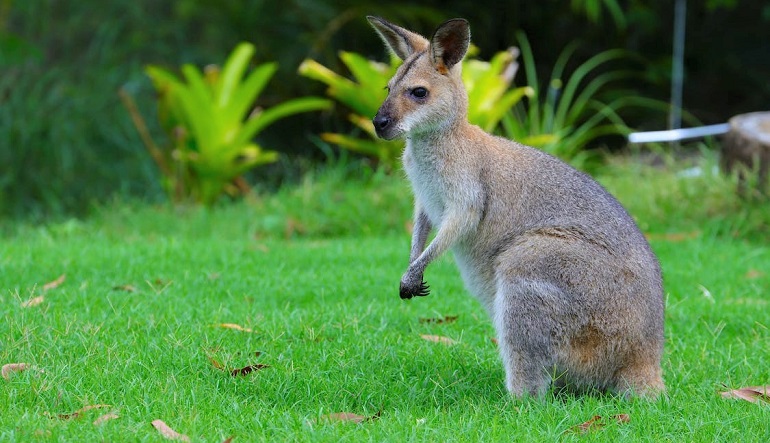
Several threats face the survival of wallabies. These include a lack of genetic diversity, a loss of habitat, and competition for food and territory from other species.
Similarly, hunting and predators pose a challenge to wallaby survival rates. They face additional threats from vehicle collisions, disease, animal agriculture, and culling as pests. They are also used for show purposes.
The Commonwealth Environment Protection and Biodiversity Conservation Act 1999 and the International Union for Conservation of Nature (IUCN) list specific wallaby species as vulnerable, threatened or facing extinction. Several of these are:
- Brush-tailed Rock – vulnerable
- Proserpine Rock – endangered
- Yellow-footed Rock – near threatened
- Rufous Hare – vulnerable to extinction
- Black-footed Rock – vulnerable to extinction
- Bridled Nail-tail – vulnerable to extinction
- Brush-tailed rock – declining and small population numbers are as low as 20,000 and less than 10,000 in some areas
Examples of extinct wallabies include the following three species:
- Eastern Hare wallaby
- Crescent Nail-tail wallaby
- Toolache wallaby
While you can raise a roo or a wallaby as a pet, you will need a permit.
12. FAQs
What Is the Favorite Food of Wallabies?
Their favorite foods consist of various types of grasses.
Are Wallabies and Kangaroos the Same?
They belong to the same family but not the same genus. These are not the same, but they are related.
Can I Pet a Wallaby?
If it is domestic, you can pet it. However, this animal remains wild, so you should always respect it. Wallabies can be as unpredictable as they can be cute and adorable.
How Fast Can a Wallaby Travel?
The swiftest wallabies can move as quickly as 29 miles per hour.
Conclusion
Now that you know that wallabies are not roos but a group of smaller types of macropods, you can share your new knowledge with others. It is also rewarding to understand more about these adorable macropods, especially since they are vulnerable to extinction.
Fortunately, the Australian authorities are aware of this fact and engage in conservation programs to prevent any more of them from becoming extinct.


